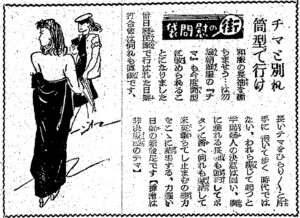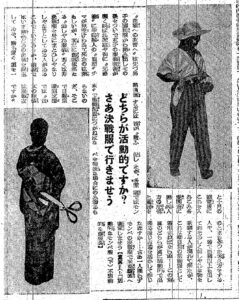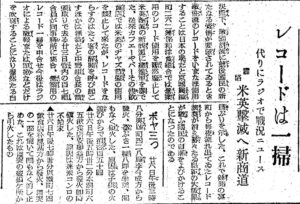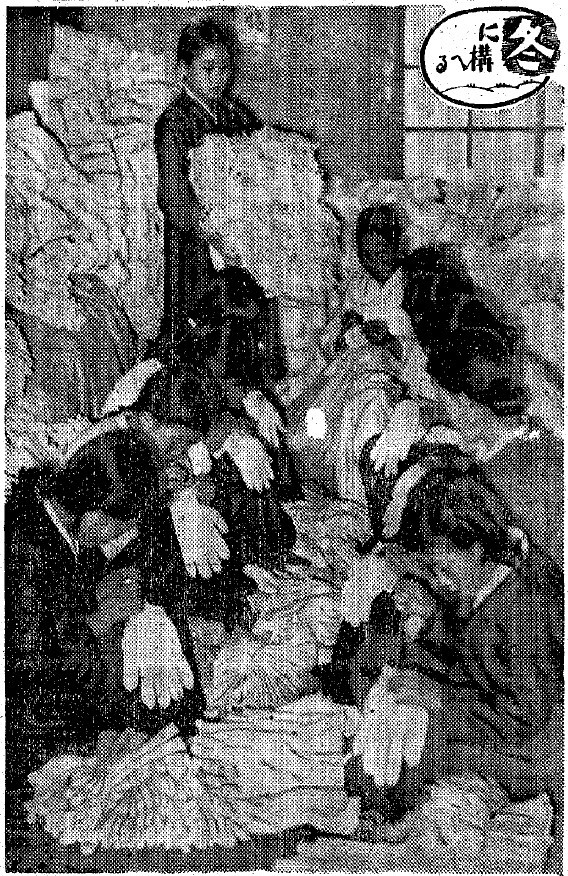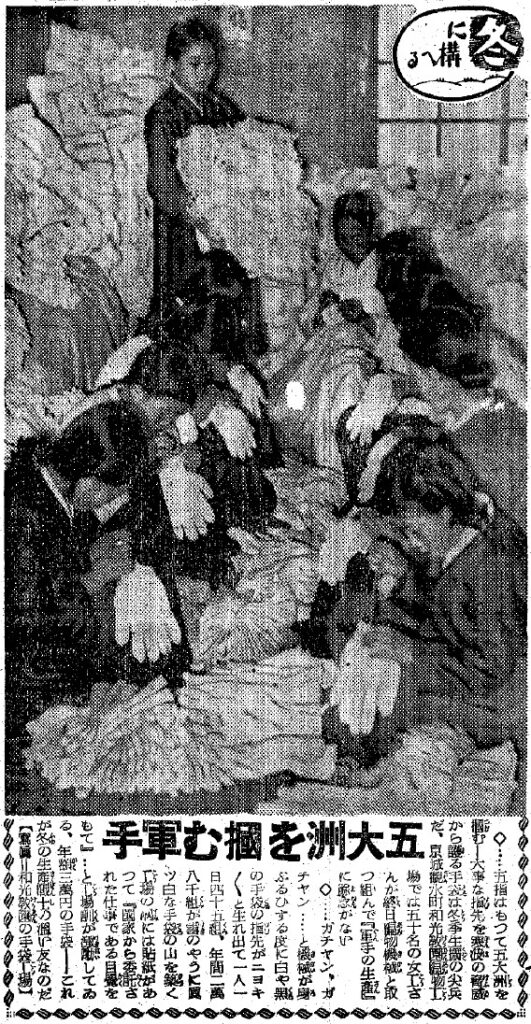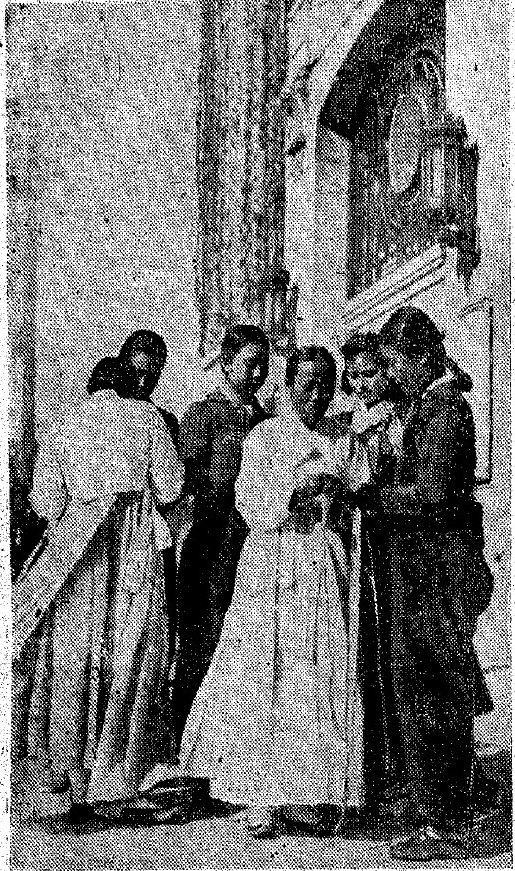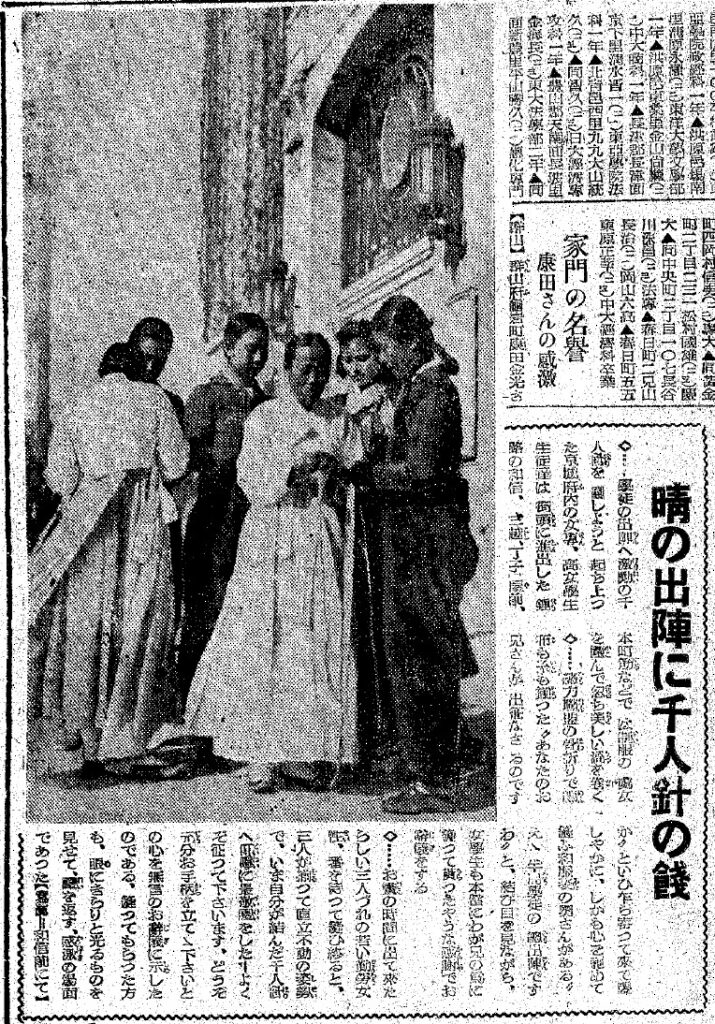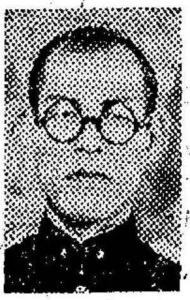In September 1943, almost two years into waging war against the United States and Britain, facing extreme shortages in everything from food to clothing, Imperial Japan imposed some draconian clothing restrictions regulating what Koreans can and cannot wear, framing these regulations in the name of promoting a 'minimalist lifestyle' that would conserve resources and eventually win the war. Enforcement of the regulations was performed by the Korean Federation of National Power (国民総力朝鮮連盟, 국민총력조선연맹), which functioned as the one and only political party of Korea, and the patriotic groups (JP: aikoku-han, KR: aeguk-ban, 愛國班), which were the local level neighborhood cells of the political party.
It was very difficult to translate all the clothing-specific terminology, so I did my best to add outside images and links to Wikipedia and other online resources to make sense of what was being referred to in these articles.
(Translation)
Gyeongseong Ilbo (Keijo Nippo) September 22, 1943
The War Lifestyle Reader Series: Clothing
Men are to wear National Uniform Type B
Short sleeves and maru-obi for women are abolished
Modern warfare is a total war in which all domestic resources are concentrated on achieving the objectives of the war. Therefore, the national people on the home front are no different from the front-line combatants, and their daily lifestyle is literally a war lifestyle. This transformed form of war lifestyle, which cannot be governed by the peacetime assumptions of what a war lifestyle is supposed to be like, is not to be lived under the meager goal of 'stabilizing the lifestyles of the people'. Rather, it is to be lived under the goal of enduring the 'minimalist lifestyle', which is truly ruthless and merciless. The 'minimalist lifestyle' is a way of life in which food, clothing, and shelter, the three essential conditions for human existence, are reduced to the minimum. The last victors of modern warfare will be the people who can endure this simple lifestyle and succeed in waging this war, which is the great objective of the nation. This column is an attempt to describe this minimalist lifestyle from an economic perspective, and is entitled the 'War Lifestyle Reader'.
In order to win the Greater East Asia War, everything in the nation is being rapidly shifted to a decisive war-fighting posture, and the most urgent issue at hand is the complete simplification of food, clothing, and shelter, the largest elements of national life. Among these, the simplification of clothing was decided upon at a regular cabinet meeting held on June 4 this year with the "Outline for the Simplification of Wartime Clothing", and this was implemented in mainland Japan on August 10. Therefore, in order for Korea to follow suit, the Governor-General's Office issued a statement on August 22, clearly stating the policy to secure essential clothing and thoroughly conserve clothing materials. The main points were the following:
(1) Essential items necessary for the people's clothing are to be selected.
(2) Simplification is to be done without regard to mere hobbies, tastes, fashions, or business customs, as had been done in the past.
(3) Goals have been set to rationalize yarn consumption, improve quality, and rationalize production.
(4) In consideration of the difficulties in supplying materials and reconfiguring facilities, the best use shall be made of existing facilities as much as possible.
Before, there were 135 types of wide fabrics and several thousand types of narrow fabrics, but the standards were reorganized into 6 types of rayon fabrics, 13 types of mixed rayon fabrics, 64 types of silk fabrics, and 30 types of mixed silk fabrics, for a total of 113 types.
The Korean Textile Association, the Korean Federation of National Power, the Patriotic Women's Association of Korea, and other related organizations will soon play a central role in the "wartime clothing simplification campaign" to simplify the clothing of the people in all of Korea. The policies, guidelines, and outlines are the following:
▲Policy: Simplify the general clothing of the people, abolish luxury goods, raise morale, and improve the physical condition of the people while considering the special circumstances of Korea. Mental tension must be maintained to strengthen and renew the wartime lifestyle while not losing the sense of simplicity and beauty of the Japanese people, and clothing materials must be actively conserved in light of the current supply and demand situation for textile materials.
▲Guidelines:
- In addition to greatly simplifying the types and standards of textiles, a designated production system will be implemented across the board to greatly minimize the production of high-end and non-urgent products.
- In dyeing, the use of flamboyant colors shall be avoided, and color schemes shall be limited to plain colors of the highest quality.
- In the tailoring of clothing, the amount of fiber shall be reduced as much as possible, while at the same time making it more active and hygienic.
- Organizations shall avoid the establishment of new uniforms from now on, and take measures to utilize national uniforms or plain clothes (even in cases where uniforms have already been established, measures shall be taken to permit the wearing of non-regulation clothing, unless there are particular obstacles to this).
- With regard to personal effects and other household articles, their types and standards shall be simplified as much as possible, and the manufacture of luxury and non-urgent items shall be prohibited.
- The manufacturing of new clothing shall be suppressed, and the rehabilitation of whatever clothing is on hand shall be thoroughly promoted as much as possible, and the ceremonial dress for weddings, funerals, and other general ceremonies shall be simplified.
Guidelines for the Simplification of Clothing
I. The following points shall be taken into consideration with regard to fabrics
- For the Kijaku type of silk fabrics, production shall be concentrated on products in demand by the masses as much as possible.
- For narrow fabrics and fabrics for obi, widths and lengths shall be shortened to conform to those of mainland Japan, and the production of luxury and non-urgent products shall be prohibited.
II. Regarding dyeing, the use of ornate colors and patterns shall be abolished in favor of plain colors of high quality, and the number of colors shall be limited to three or less.
 |
| Right: National Uniform Type B, Left: National Uniform Type A |
III. The following guidelines shall be applied to the tailoring of clothing for both men and women.
- Men's clothes: (a) The ceremonial clothes and activewear of adults (21 years of age and over) shall be based on the National Uniform Type B, and newly tailored suits shall be prohibited (b) New home clothes shall not be made at all, and they shall be limited to the tanzen kimono in the winter and military clothes (yukata) in the summer (c) For Korean-style clothes, sleeveless vests shall be abolished, and the string fasteners of upper and lower garments shall be replaced with buttons (d) The activewear for young men (including secondary, vocational, and college students from 14 to 20 years of age) shall be made in the same way as that of adult men 21 years of age and older (e) The home clothes of young men shall be replaced with activewear, and all new tailoring shall be of the National Uniform Type B (f) The home clothes of school children (from 7 to 13 years of age) shall be replaced with school children's uniforms, and the uniforms shall not be particularly limited to a certain type (g) Infants (6 years old and under) shall be dressed in infants' clothes. (h) Newly tailored cloaks shall be single-breasted and have a stand-up collar.
- Women's clothes: (a) Ceremonial clothes shall not be newly manufactured. For celebratory and somber occasions, an insignia shall be applied to turn the clothes into ceremonial clothes (b) Japanese-style clothing shall be tailored with short sleeves, and standard women's clothing (Western-style type 1, Western-style type 2, and activewear) shall be worn as much as possible (c) For Korean-style clothes, all string fasteners shall be replaced with buttons, and chima dresses shall be tubular (d) For young women's activewear, blouses, skirts, and one-piece dresses shall be worn in the summer, and jumpsuits and skirts in the winter (e) For adults and young women, standard women's clothing (Japanese-style type 2) and Monpe work pants shall be the main type of home clothes (f) Nagajuban kimono underwear and other ready-made kimono items should be abolished as much as possible (g) Maru-obi and fukuro-obi shall be abolished, and the use of Nagoya-obi, katagawa-obi, and hitoe-obi shall be with shorter widths and lengths (h) Embroidery and shibori dyeing on lapels shall be discontinued (i) Schoolgirl uniforms shall not be particularly limited to a certain type, and the removal of decorative parts shall be in accordance with the standard women's clothing as far as possible (j) The clothing of school children and infants shall be in accordance with those for male school children and male infants.
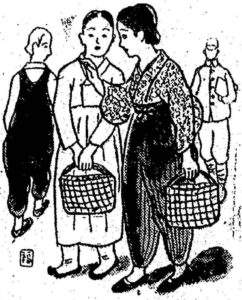 |
| Left to right: woman in jumpsuit, woman in tubular-style chima dress, woman in Monpe workpants, man in National Uniform Type B |
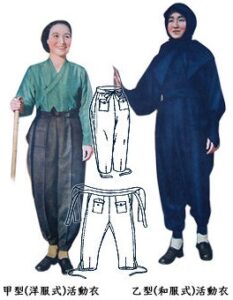 |
| Women's activewear |
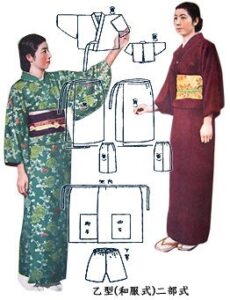 |
| Japanese-style Type 2 |
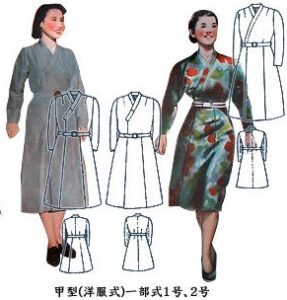 |
| Western-style type 1 |
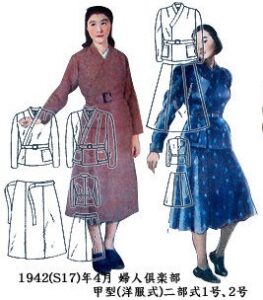 |
| Western-style type 2 |
IV. Others
- Dress shirts shall be with single cuffs.
- The manufacture of new neckties shall be prohibited.
- Underwear shall be mainly made of woven fabrics for summer wear, and mainly made of knit yarn for winter wear.
- Socks shall be plain in color and short in length.
- New hats shall be military hats.
- Summer gloves shall be discontinued for both men and women.
- Women's hats shall be abolished.
- Socks for female students shall be short socks in the summer.
- Underwear shall be simplified in their varieties and standards, and the chemise shall be abolished.
As described above, both men and women are required by the national government to thoroughly simplify their clothing. Originally, humanity was born naked, and they used to wear grass and leaves over parts of their bodies, but as human culture improved, they began to wear clothes covering all parts of their bodies. Subsequently, people have come to compete over flamboyant fashion trends. However, in a time of war, it is unacceptable to wear clothing that merely satisfies one's vanity. This is why there are calls for the simplification of wartime clothing, but in practicing such simplification, it is necessary to change to wartime clothing suitable for Japan the fighting nation without losing the Japanese sense of simplicity and beauty.
Source: https://www.archive.org/details/kjnp-1943-09-22
Gyeongseong Ilbo (Keijo Nippo) August 31, 1943
Farewell to the old chima dress! Go with the new tubular style of the chima dress!
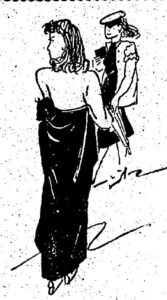 |
| "Chima dress which is inappropriate for fighting decisive battles" |
Let's cut off the long sleeves of Japanese-style clothes. Of course, the chima dress of Korean-style clothes will also be changed to a tubular style. The meeting of the Patriotic Women's Association held at the Seoul Citizens Hall on August 30 had a serious tone. It is no longer the time to walk around wearing a long chima dress, holding it in one hand and waving it around. We Korean women are strongly determined to stand firm. We will save the long string fasteners that hang down from our chests and replace them with buttons, and we will donate the string towards the war effort, gathering all our strength to stop the United States and Britain from attacking us. Such is the powerful initiative of the Patriotic Women's Association. [The inserted image is that of a chima dress which is not appropriate for fighting decisive battles]
Source: https://www.archive.org/details/kjnp-1943-08-31
Gyeongseong Ilbo (Keijo Nippo) October 17, 1943
Which is more appropriate as activewear? Let's get dressed for battle!
The "change of clothes for battle" started with the national uniform for men, followed by widespread calls for improved clothing for women, with 'Genroku sleeves' for men and 'tubular-style chima dresses' for Korean women being seen at home and on the streets. It is encouraging to see the 'Genroku sleeves' for men and 'tubular-style chima dresses' for Korean women in homes and on the streets, but there are still people wearing old 'fashionable clothes' or uniforms which are inappropriate for fighting decisive battles. Is this the right thing to do? On the front lines, bloody battles are being fought over and over again. In order to march forward on the road to victory, everyone must be deployed into a battle posture in "fighting clothes".
The Gyeonggi-do Branch of the Patriotic Women's Association included the question, "Are you wearing battle clothes?" in its October circular, and circulated it to all patriotic groups to encourage women to reflect and get inspired. However, some households began to mistakenly believe that Monpe work pants are to be worn only for special occasions, and others began to buy new, fashionable clothes spending more than 100 yen per piece. These battle clothes are the only daily activewear that should be worn.
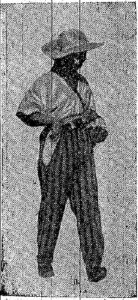 |
| Monpe work pants |
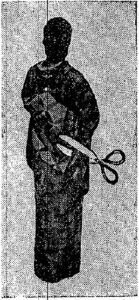 |
| Non-active type Kimono |
Which of these two pictures show old clothes which must be remade as much as possible into true activewear? Let us all march forward, wearing our Monpe work pants as battle clothes, to destroy the United States and Britain! [Photos: the top photo shows an active type of Monpe work pants; the bottom photo shows old-style clothes of a non-active type]
Source: https://www.archive.org/details/kjnp-1943-10-17
Credit to むかしの装い http://blog.livedoor.jp/mukashi_no/archives/35803975.html
(Transcription)
京城日報 1943年9月22日
戦争生活読本:衣の巻
男子は国民服乙号
婦人は短袂、丸帯廃止
現代戦は国内の凡ゆる事物を一切合財挙げて戦争目的完遂に集中する総力戦である。だから銃後国民と雖も、前線の戦闘員と何ら異なるところなく、その日常生活は文字通りの戦争生活であり、従って生活様式も戦争生活という平時の常識をもっては到底律することのできぬ相貌を持つこの変貌した戦争生活は、曾ての『国民生活の安定』などというような微温的な目標の下に営まれるものでなしに、真に無慈悲仮借なき『最低生活』に耐えることにある。『最低生活』とは人類生存における三大不可欠条件たる衣食住をとことんまで引き下げた生活様式と云うのであり、この簡素な生活をものともせず克く耐え、国家の大目的たる戦争を成功せしめ得る民族こそ現代戦の最後勝利者である。そこでこの最低生活を経済的観点から述べんとするのが本欄の試みであり、題して『戦争生活読本』という。
大東亜戦争を勝ち抜くために、国家のあらゆるものが急速に決戦態制へ切り替えられつつあり、就中国民生活の最大要素をなす衣食住の徹底的簡素化が当面緊急の問題としてとりあげられて来た。そのうち、衣生活の簡素化については本年六月四日の定例閣議に於いて『戦時衣生活簡素化実施要綱』を決定し、内地は八月十日より実施した。よって朝鮮もこれに順応するため八月二十二日総督府当局談を発表し、必需衣料品を確保すると共に衣料資材の徹底的節約を図る旨の方針を明かにした。その要点は
一、国民衣生活に必要欠ぐからざるものを選定したこと
二、従来の如く単なる趣味、嗜好流行及び商習慣に捉われることなく単純化したこと
三、原糸消費の合理化、品質の向上並びに生産の合理化を目標としたこと
四、資材の補給難、設備の改造難等を考慮し、出来得る限り現有設備の活用を期したこと
などで、規格も従来は広幅織物百三十五種、小幅織物数千種であったものが人絹織物六種、人絹交織物十三種、絹織物六十四種、絹交織物三十種、合計百十三種に整理されたのである。
この衣生活簡素化実践については近く朝鮮織物協会をはじめ国民総力朝鮮聯盟、日婦朝鮮本部その他関係団体が中心となって全鮮的に”戦時衣生活簡素化運動”を展開することになっているが、その方針、要綱、要領は左の通りである。
▲方針:国民一般衣料を簡素化して奢侈高級品を廃し、朝鮮の特殊事情を考慮し士気の昂揚、体位の向上をはかり、日本人的な簡素美を失わず、戦時生活の強化刷新と精神的緊張を持たしむると共に現下繊維資材の需給関係にかんがみ積極的に衣料資材の節約を図るものとす。
▲要綱:1、織物に就いてはその種類、規格を極度に単純化するは勿論、全面的な指定生産制を実施することに依り高級品及び不要不急品の生産を極力圧縮すること
2、染色に就いては努めて華美を避け質実清楚を旨とし、配色等を限定するの措置を講ずること
3、衣服の仕立てに就いては繊維量を極力節約すると共に活動的、衛生的たらしむること
4、諸団体に於いて今後新たに制服等を制定するを避けしめ国民服又は平常服を活用する方途を講ずること(既に制服等の定める場合と雖も特に支障なき限り制規以外の服装の着用をも認むるよう措置すること)
5、見廻品その他家庭用品に就いては、その種類及び規格を極力単純化し高級品並びに不要不急品の製造を禁止すること
6、衣料の新調を抑制すると共に極力有合わせ品の更生活用の徹底をはかると共に婚礼、葬儀その他一般儀礼の場合における儀装の簡素化をはかること
衣生活簡素化実施要領
一、織物に就いては左の点につき考慮する
1、着尺用絹織物については極力大衆需要品に生産を集中せしむること
2、小幅織物、帯地等は内地に順応し幅及び長さを短縮するのほか高級品及び不要不急品の生産を禁止すること
二、染色に就いては華美な色彩、柄模様を廃止して高尚清楚とし染色の色数に就いては三色以下に限定すること
三、衣服の仕立てに就いては男女とも左の要領に依らしむること
1、男子衣料(イ)大人(二十一歳以上)の式服、活動衣は国民服乙号型を原則とし脊広の新規仕立てを禁止すること(ロ)家庭着は努めて新調を見合わせ、冬は袷丹前、夏は軍衣(浴衣)程度に止めること(ハ)鮮服はチョッキを廃し上衣、周衣の紐はボタンに改むること(ニ)青年(十四歳以上二十歳迄中等、専門、大学生を含む)の活動衣は大人に準ずること(ホ)青年の家庭衣は各活動衣をもって之に代らしむること、新規仕立ては総て国民服乙号型とすること(ヘ)学童(七歳以上十三歳迄)の家庭着は学童服をもって代らしめ制服を限定せざること(ト)幼児(六歳以下)は幼児服とすること(チ)外套の新規仕立ては立襟、片前とすること(リ)袷オーバー、レインコート等は新規仕立てを禁ずること
2、女子衣料(イ)式服は新調せず慶弔には徽章を応用して式服に代えること(ロ)和装の仕立てについては短袂に依らしむる如く措置することとし、極力婦人標準服(甲型一部式、甲型二部式、活動衣)とすること(ハ)鮮服は各紐類をボタンに替え、チマは筒型となすこと(ニ)青年の活動衣は夏はブラウスとスカート、ワンピースとし、冬はジャンパーとスカートとすること(ホ)大人、青年の家庭着は婦人標準服(乙型二部式)及びモンペを主とすること(ヘ)長襦袢その他和装既成品はできるだけ廃止すること(ト)帯は丸帯袋帯を廃止し、名古屋帯、片側帯、単重帯とし、幅及び用尺を短くすること(チ)半襟の刺繍、絞りを廃止すること(リ)女学生の制服は限定せざると共に、その装飾的部分の除去については可及的婦人標準服に依らしむること(ヌ)学童、幼児の衣服は男衣服料に準ずること
四、その他
1、ワイシャツはカッター(シングルカフス)とする
2、ネクタイの新調、製造を禁止する
3、肌着類の夏物は布帛製品を主とし、冬物はメリアス製品を主とする
4、靴下は色無地とし、その長さを短くする
5、帽子の新調は戦闘帽とする
6、夏手袋は男女共に廃止する
7、女子の帽子は廃止する
8、女学生の靴下は夏期に於いては短靴下とする
9、肌着類は品種、規格を単純化しシュミーズは廃止する
以上のように男女とも徹底した衣生活の簡素化を国家的に要請されているのである。元来人類は裸で生れ出るのであり、そのかみは局部に草葉を纏まっていたものが文化の向上につれて全身に衣服を着用するようになった。そして更に華美流行を競うようになったのであるが、決戦下にあっては見栄を満足させるに過ぎぬような衣生活は到底許されぬのである。さればこそ戦時衣生活の簡素化が叫ばれるのであるが、その実践に当っては飽くまで日本的な簡素美を失わずに戦う日本にふさわしい戦時衣服に改めるべきであろう。
京城日報 1943年8月31日
チマと別れ、筒型で行け
和服の長袖を断ちましょう、は勿論朝鮮服の『チマ』も今度筒型に改められることになりました。三十日府民館で行われた日婦打合せ会は何れも真剣です。長いチマをひらりひらりと片手に抱いて歩く時代ではない。われら断じて起つと半島婦人の決意は固い。胸に垂れる長紐も節約してボタンに替え何れも献納して米英撃ちて止まむの総力をここに結集する、力強い日婦の新発足です【挿絵は非決戦型のチマ】
京城日報 1943年10月17日
どちらが活動的ですか?さあ決戦服で行きましょう
”決戦への衣替え”は先ず男子の国民服から踏み出し、その後をついで女子の服装改善が広く叫ばれ、家庭や街に”元禄袖”に半島婦人の”筒型”チマが見受けられて来たのは頼もしいが、未だに旧態依然たる”おしゃれ服装”若しくは非決戦服を身にまといしゃなりしゃなりとしている人がいる。これでよいだろうか。前線ではいま血みどろの決戦を繰り返している。勝ち抜く道を一路邁進するには皆が”戦う衣”で戦闘配置につかねばならないのだ。
そこで日婦京畿道支部では”貴女の服装は決戦衣ですか”と十月の回覧板にこれを入れこみ、各愛国班に廻し婦人方の反省と奮起を促したが、各家庭ではモンペを特殊な場合にのみ着るものとまちがった考え方をする人や、一着で百円以上も出しておそろしくおしゃれな物を新調する人が現れて来たが、これは唯日常の活動服として着用せねばならぬ。
この写真のどちらが真に活動的に出来る限り古着を活かして作りなおすか。さあ一人残らずモンペの決戦服で米英撃滅へ進軍しましょう【写真=(上)活動的なモンペ服(下)不活動的な旧服装】

